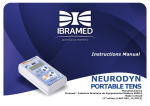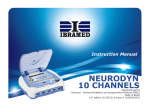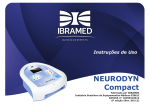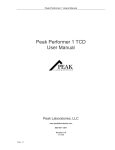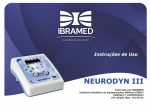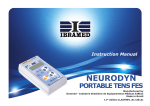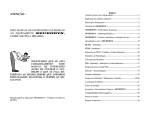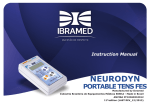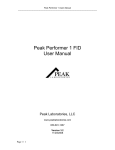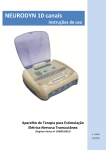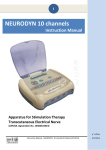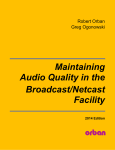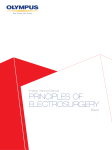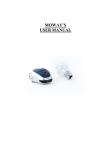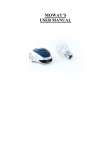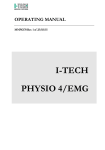Download NEURODYN AUSSIE SPORT
Transcript
NEURODYN AUSSIE SPORT Manual of Operation 2nd edition (07/2011) Equipment for Electrical Stimulation Therapy Nerve Transcutaneous 2 ATTENTION: THIS MANUAL OF INSTRUCTIONS REFERS TO NEURODYN SPORT EQUIPMENT MANUFACTURED BY IBRAMED AUSSIE PLEASE READ THIS MANUAL CAREFULLY BEFORE USING THE EQUIPMENT AND ALWAYS REFER TO IT WHENEVER DIFFICULTIES APPEAR. KEEP THIS MANUAL ALWAYS AT HAND. Manual of Operation - NEURODYN AUSSIE SPORT 2nd edition (07/2011) 3 TABLE OF CONTENTS General care with the equipment. ..................................................................................... 5 Explanation of the symbols used. ..................................................................................... 6 Preliminary observations. ................................................................................................. 8 Description of NEURODYN AUSSIE SPORT ............................................................. 8 NEURODYN AUSSIE SPORT– Essential Performance ............................................... 8 NEURODYN AUSSIE SPORT– Electrical AC Input ................................................... 12 NEURODYN AUSSIE SPORT- Controls, indicators, and operation instructions ....... 13 How to use the NEURODYN AUSSIE SPORT .............................................................. 16 AUSSIE current (Australian Current)............................................................................... 27 What is really AUSSIE current (Australian Current)? ..................................................... 30 Care and Counter-Indications ........................................................................................... 36 Placement of the Electrodes ............................................................................................. 37 Electrodes – Recommendations ........................................................................................ 40 Electrodes – Biocompatibility .......................................................................................... 40 Environmental protection.................................................................................................. 41 Electrode Cleansing . ........................................................................................................ 41 Warranty and Technical Assistance. ................................................................................ 42 Troubleshooting ............................................................................................................... 42 Warranty Term ................................................................................................................. 43 Accessories included with NEURODYN AUSSIE SPORT .......................................... 45 NEURODYN AUSSIE SPORT– Technical Characteristics ......................................... 46 Bibliographic References ................................................................................................. 48 Electromagnetic compatibility. ......................................................................................... 50 Manual of Operation - NEURODYN AUSSIE SPORT 2nd edition (07/2011) 4 ATENÇÃO RISCO DE CHOQUE ELÉTRICO NÃO ABRIR The lightning bolt symbol inside a triangle is a warning about the presence of “dangerous voltage”, without insulation in the internal part of the equipment which may be strong enough to cause risk of electrical shock. An exclamation mark inside a triangle alerts the user about the existence of important operation and maintenance instructions (technical service) for this equipment. ATTENTION: To prevent electrical shock do not use the equipment plug attached to an extension cable or to any other type of plug except that the terminals fit perfectly in the receptacle. Disconnect the input plug from socket when not using the equipment for a long period of time. Manual of Operation - NEURODYN AUSSIE SPORT 2nd edition (07/2011) 5 General care with the equipment: NEURODYN AUSSIE SPORT does not need special installation provisions or care. We suggest that you: Avoid places subject to vibrations. Install the equipment on a firm and horizontal surface, in a site with perfect ventilation. In case of a built-in cupboard, make sure that there is no obstacle for the free air circulation on the back of the equipment. Do not lay it on carpets, rugs, cushions or other soft surfaces that can obstruct the ventilation. Avoid humid, hot and dusty places. Place the cable in order to leave it free, out of places where it can be trodden on, and do not place any furniture over it. Do not insert objects into equipment orifices and do not place recipients with liquid on it. Do not use volatile substances (benzene, alcohol, thinner and solvents in general) to wipe the equipment cabinet because they can damage the finishing. Use only a soft, dry, and clean piece of cloth. Manual of Operation - NEURODYN AUSSIE SPORT 2nd edition (07/2011) 6 Explanation of the symbols - used ATTENTION! Check and follow the instructions in this manual. - Equipment CLASS II. The protection against electric shock is not based only in the basic insulation but also incorporates additional safety precautions, such as double or reinforced insulation, not holding grounding resources protection or depending on installation conditions. - Equipment with BF type applied part. - Risk of electrical shock. IPX0 - Equipment not protected against harmful water dripping. - Indicates electrostatic discharge sensibility - Indicates the starting of the action (START) - Indicates the end of the action (Stop) - Indicates: Off (without electrical power supply) - Indicates: On (with electrical power supply) V~ - Volts in Alternate Current ~ line - Alternate current power line In the Transportation Box: Manual of Operation - NEURODYN AUSSIE SPORT 2nd edition (07/2011) 7 -FRAGILE: The content in this package is fragile and should be handled with care. -THIS SIDE UP: Indicates the correct position to ship the package. 50ºC - TEMPERATURE LIMITS: Indicates the limit temperatures for transportation and storage the package. 5ºC - KEEP IT AWAY FROM THE RAIN: This package should not be shipped under rain. 08 - MAXIMUM STACKING NUMBER: The maximum number of identical packages which can be stacked. For this equipment, the limit stacking number is 8 units. Manual of Operation - NEURODYN AUSSIE SPORT 2nd edition (07/2011) 8 Preliminary Observations: NEURODYN AUSSIE SPORT is an electrical stimulator used in medium frequency therapies. These techniques are noninvasive, without systemic effects, they do not cause dependency and do not have undesirable side effects. As for the type and degree of protection against electrical shock, the NEURODYN AUSSIE SPORT corresponds to a CLASS II EQUIPMENT with BF type of safety and protection. It must be operated only by qualified professionals and in properly authorized medical departments. The use of these units is not intended for rooms with risk of explosion such as anesthesia departments or the presence of an anesthetic flammable mixture with air; oxygen or nitric oxide. POTENTIAL ELECTROMAGNETIC INTERFERENCE: As for the limits regarding electromagnetic disturbance, Neurodyn Aussie Sport is electro-medical equipment that belongs to Group 1, Class A. The simultaneous connection of the patient to the NEURODYN AUSSIE SPORT stimulator and to surgical equipment of high frequency can cause burns in the application area of the electrodes and it may damage the stimulator. The operation at a short distance (1 meter, for example) of a short wave or microwave therapy equipment can produce instability in the output of the equipment. In order to prevent electromagnetic interference, we suggest that one group of power supply line is used for NEURODYN AUSSIE SPORT and another separate group for the short wave and microwave equipment. We also suggest that the patient, o NEURODYN AUSSIE SPORT and the connection cables are placed at least at a distance of 3 meters away from the shortwave or microwave therapy equipment. Radio frequency communication equipment, mobile or portable, may cause interference and affect the functioning of o NEURODYN Evolution. Description of NEURODYN AUSSIE SPORT: NEURODYN AUSSIE SPORT was designed following the existing technical manufacturing standards for medical equipment (NBR IEC 60601-1 NBR IEC 606011-2 and NBR IEC 60601-2-10). BASIC OPERATION: Neurodyn Aussie Sport is equipment for the application of electrical current via electrodes in contact with the patient. It is a transcutaneous muscular stimulator with microcomputer technology, this means, it is microcontrolled. The Neurodyn Aussie Sport stimulator produces AUSSIE CURRENT (also called Australian Current), a "new generation” of electrical current for stimulation, with advantages as to the (Russian, Interferential, TENS and FES) stimulation methods. This technique is noninvasive, without systemic effects, it does not cause dependency and it does not have undesirable side effects. Manual of Operation - NEURODYN AUSSIE SPORT 2nd edition (07/2011) 9 The current intensity necessary for the treatment depends on the type of dysfunction to be treated as well as the thresholds of every patient. Thus, the treatment should start with minimum intensity levels (very low), increasing the level carefully until achieving the effects adequate for the procedure and according to each patient's sensory, motor and pain reaction. When an individual is submitted to an electric stimulation, he/she will have an itchy feeling on the stimulation location or in the areas between the electrodes. Generally this feeling is comfortable to most of the persons. However, others report it is unpleasant. Neurodyn Aussie Sport produces an stimulus, whose wave shape is much more comfortable than any of the traditional methods of stimulation. Thus, it is more probable that this stimulus is much more pleasant to most patients. The degree of feeling is controlled by the adjustment of the equipment parameters (controls). However, as it has been stated previously, sensory and motor stimulation can be accomplished with minimal pain due to the fact that the current stimulation of Aussie current is more pleasant than most traditional electrical stimuli (Russian, Interferential, TENS and FES). Due to the fact that the utilized technology is the same microcomputer technology, these controls operate using the touch screen. All the information regarding the parameters chosen by the professional therapist will be shown in the alphanumeric liquid crystal screen. NEURODYN AUSSIE SPORT offers two types of stimulation : - Sensory Stimulation (maximum confort) and - Motor stimulation (maximum torque). Aussie Current – Sensory Stimulation (maximum comfort) : - For sensorial stimulation (maximum comfort) , a sinusoidal current with 4,000 Hz frequency and modulation in Bursts with a duration of 4 ms is used Sensory stimulation (maximum comfort) produces a torque than motor stimulation (maximum torque) and can be used, for example, in cases of pain and discomfort caused by different types of tissue lesions. This type of stimulation is the best for the control of pain via the "theory of the gates" originally presented by Melzack and Wall (1965) as well as in function of the release of endogenous opiates In this case, the need is not the production of muscular torque but the activation of the ABeta nervous fibers (large nervous fibers) with a minimal activation of the fibers of small diameter A Delta and C (pain). Aussie Current – Motor Stimulation (maximum torque) : For motor stimulation (maximum torque) , a sinusoidal current with 1,000 Hz frequency and modulation in Bursts with a duration of 2 ms is used Manual of Operation - NEURODYN AUSSIE SPORT 2nd edition (07/2011) 10 The frequency from 40 -50 Hz is recommended for stronger contractions. Frequencies higher than 50 Hz produce more torque, however a certain degree of fatigue may occur. The fatigue caused by higher frequencies is not due to the tired fibers of the muscle, but due to the result of the electrical activity which stopped being able to activate the contractile mechanisms of the muscle fibers. When fatigue becomes a problem, lower (20-40 Hz) burst frequencies must be used. A lower torque will be produced, however, we will obtain a lower fatigue rate. For some conditions, for example, prevention of the subluxation of a shoulder after a cerebral vascular accident, even lower frequencies are recommended. The treatment must physiologically simulate the normally used frequencies in order to activate the slow contraction fibers or muscle fibers resistant to fatigue in relatively low levels of activity sustained for longer time periods in order to prevent or limit the atrophy or stretching of the articular capsule. Frequencies between 10 Hz and 20Hz are recommended. Consequently, this is not simply about producing maximum muscular torque, but also to produce a motor stimulation with higher efficiency. Stimulation Options: The NEURODYN AUSSIE SPORT stimulator has 4 output channels with independent intensity controls. Thus, 4 different areas can be stimulated separately or together during a training session. NEURODYN AUSSIE SPORT generates Aussie Current (also called, AUSTRALIAN current) – type of sinusoidal current with a frequency carrying , 1,000 Hz or 4,000 Hz with a burst duration of 4ms or 2ms, modulated in pulse trains (bursts) with variable frequency from 1 to 120 Hz. NEURODYN AUSSIE SPORT allows for the following stimulation modes: - CONTINUOUS MODE (Cont.): The stimulation sensation is continuous and constant. - SYNCHRONIZED MODE (Sinc.) (with gradients: On, Off, Rise and Decay): The four channels work at the same time, synchronized. The stimulation sensation follows the times chosen in the On, Off, Rise and Decay gradients. - ALTERNATE MODE (Rec.) (with gradients: On, Off, Rise and Decay): Channels 1 to 3 work alternately with channels 2 and 4. The stimulation sensation follows the times chosen in the On, Off, Rise and Decay gradients. Manual of Operation - NEURODYN AUSSIE SPORT 2nd edition (07/2011) 11 The equipment also allows parameters: for the selection of the following TIMER – Allows for the selection of an application time from 1 to 60 minutes. At the end of the selected time, a sound will be heard the passing of current to the patient will stop. The selected value will decrease at the same time in which such time is elapsed. Burst Frequency – the burst frequency (pulse trains frequency) can be selected by the therapist in the range from 1 to 120 Hz. Burst Duration – the burst duration (length of the pulse trains) can be selected by the therapist in 2 ms and 4 ms. RISE (pulse increase gradient) – pulse increase time, variable from 1 to 20 seconds. Regulates the contraction speed, this means the time from the start through the maximum muscular contraction. Long times produce a slow, more gradual contraction. Low times produce a more sudden contraction. DECAY (pulse decrease gradient) – pulse decrease time, variable from 1 to 20 seconds. Regulates the speed through which the contraction is reduced, this means the time from maximum contraction through muscular relaxation. High times produce um slow relaxation. Low times produce a sudden relaxation. (sudden) ON TIME (connection time) – maximum muscle contraction time, variable from 1 to 60 seconds. Regulates the time that the current circulates through the electrodes during each stimulation cycle. OFF TIME (disconnection time) – rest muscle contraction time, variable from 1 to 60 seconds. Regulates the time that the current does not circulate through the electrodes during each cycle. PROGRAMS (pré-programmed protocols ): the programs are available by touching a key. It is only necessary to select the program and immediately define the intensity of the treatment. Note: Once the SINCRONIZED Mode is selected, the four channels work together at the same time, this means, the channels simultaneously execute the selected Rise, ON, Decay and Off times. Once the ALTERNATE MODE is selected, the channels 1 and 3, 2 and 4 work alternately. Manual of Operation - NEURODYN AUSSIE SPORT 2nd edition (07/2011) 12 NEURODYN AUSSIE SPORT – AC IMPUT NEURODYN AUSSIE SPORT is CLASS II monophasic equipment with BF applied part of safety and protection. Neurodyn Aussie Sport works with voltages at a range of 100 - 240 volts 50/60 Hz. Just plug in the equipment to the “power outlet” and the equipment will perform te voltage selection. The connection cable to the electric line is detachable. The equipment uses the line plug as a resource to separate electrically the circuits of the power line in all the poles. ATTENTION: The protection fuse is located on the rear part of Neurodyn Aussie Sport. To replace them, turn the equipment off, unplug it from the power outlet and, with a small screwdriver, take the protective lid off, disconnect the fuse, perform the replacement and put the lid back to its original place. Always use fuses recommended by IBRAMED: Use 2 A (20 AG) fuses, operation voltage 250V~ and fast action model 20AG (rupture current 50A). SECURITY RISKS MIGHT OCCUR IF THE EQUIPMENT IS NOT PROPERLY INSTALLED. NOTE: - There are dangerous voltages inside the equipment. Never open the equipment. - Attention: The application of the electrodes close to the thorax may increase the risk of cardiac fibrillation. NEURODYN AUSSIE SPORT Controles, indicadores e instruções de uso. Manual of Operation - NEURODYN AUSSIE SPORT 2nd edition (07/2011) 13 UPPER VIEW FRONT VIEW Manual of Operation - NEURODYN AUSSIE SPORT 2nd edition (07/2011) 14 REAR VIEW LOWER VIEW 1- ON/OFF switch. Manual of Operation - NEURODYN AUSSIE SPORT 2nd edition (07/2011) 15 2- Light Indicator (green) of ON condition. 3- BACK/NEXT keys. 4- SET+ and SET- control keys. 5- Alphanumerical liquid crystal DISPLAY 6- STAR/STOP keys The same key has two functions: START – beginning the treatment. STOP – stop the treatment. 7- PROG/MENU control keys – This key has two functions: selection of programs (treatment protocols) and menu. Consequently, according to the function, we can call it PROG or MENU key. 8- UP and DOWN control keys – Intensity from channel 1 to channel 4. 9- Luminous indicators (yellow) of channel 1, channel 2, channel 3 and channel 4, of the presence of a current intensity to the patient which can deliver a charge resistance of 1000 ohms, with a tension higher than 10 V or a current higher than 10 mA. Whenever the equipment is at a TENS intensity and type of current, this indicator will be continuously on. When the stimulation mode synchronized or alternate, this indicator will “flicker” according to the On Time and Off Time durations. We suggest to always increase the intensity during the On Time cycle, indicator on (maximum contraction). 10- Patient cable connections (channel 1 - orange color, channel 2 - black color, channel 3 - blue color and channel 4 - green color). 11- Connections of the power cable to be connected to the local AC input. See chapter Neurodyn Aussie Sport – Electrical AC Input. 12- Fuse rack - See chapter Neurodyn II – Electrical AC Input. 13- Network voltage characteristics plate. 14- Tag with the characteristics of the output current of the NEURODYN AUSSIE SPORT. 15- General characteristics tag. 16- Attention Tag: Do not open. Risk of electrical shock. Learning to use the Neurodyn Aussie Sport: Manual of Operation - NEURODYN AUSSIE SPORT 2nd edition (07/2011) 16 1 o step: Remove the equipment from the transport box and the plastic bag protection . Connect the detachable power cable (12) and connect the equipment to the local electrical network socket. 2 o step: Place the connection cables on the patient into the output connector located on the front part of the equipment. The orange cable is channel 1, the black cable is channel 2, the blue cable is channel 3 and the green cable is channel 4. 3 o step: Place the conductive silicon rubber electrodes on the banana clips located at the end of the connection cable to the patient. Connector of electrodes´cable: Safety connector of the electrode cable Banana Pins Always adjust the fixation screws of this connector Attention: 1- The fixed connector of the electrode cable has screws that must be fastened to the output connector (11) located on the equipment panel. Always tighten the screws of this connector for a perfect electrostimulation. 2- To remove the banana plugs from the electrodes, just pull them using their protection cover. Never pull them from their cable. Manual of Operation - NEURODYN AUSSIE SPORT 2nd edition (07/2011) 17 All the parameters are programmed by touch keyboard and indicated on the liquid crystal display. Descriptions and the necessary steps to operate this equipment are shown below: Field designed for the selection of the STIMULATION MODO: Cont.CONTINUOUS, Sinc. - SYNCHRONIZED, Rec. - ALTERNATE. Field destined to the selection of the parameter FREQUENCY of the CARRYING FREQUENCY: 1KHz (1.000 Hz) or 4KHz (4.000 Hz). Field destined for the selection of the parameter BURST DURATION 2ms or 4ms Field destined for the selection of the parameter BURST DURATION (repetition burst frequency): variable from 1Hz to 120 Hz. Field designed for the selection of the parameter APPLICATION TIME (TIMER). Allows for the selection of an application time of 1 to 60 minutes. Field designed to selection of PULSE ASCENDING TIME (time to go from rest to maximum contraction parameter – pulse ascending ramp), variable from 1 to 20 seconds. Manual of Operation - NEURODYN AUSSIE SPORT 2nd edition (07/2011) 18 Field designed for the selection of the parameter CONNECTION TIME (time of sustentation of the maximum muscle contraction), variable from 1 to 60 seconds. Field designed for the selection of the parameter PULSE DESCENT TIME (time to go from maximum contraction to rest – pulse decrease gradient), variable from 1 to 20 seconds. Field designed for the selection of the parameter REST TIME (time of the muscle contraction), variable from 1 to 60 seconds. Note: The RISE, ON, DECAY and OFF fields only work for the Synchronized and Alternate stimulation modes. 4 o step: Turn on – turn off key (1). When connecting the equipment, the liquid crystal screen (5) will show the following display messages for several seconds. After this presentation, the display (5) will start its operation indicating the equipment programming “default” page: Note that the STIM field of the parameter. MODE has a cursor flickering above letter C of the word Cont. This is the cursor used to select the parameters. It will always be present when the equipment is being programmed. 5 o step: BACK and NEXT (3) control keys: These keys are used to select the parameters necessary for the treatment. When pressing the NEXT key you will be taken to the next parameter. When pressing the BACK key you will be go back to the previous parameter. Note that after each selection performed through the BACK and NEXT keys the chosen parameter will remain flickering. Manual of Operation - NEURODYN AUSSIE SPORT 2nd edition (07/2011) 19 6 o step: SET + and SET - (4) control keys: These keys are used to choose the marks of each necessary parameter to the therapy. SET+ Increasing values. SETdecreasing values. 7 o step: START / STOP (6) control key. Once the parameters and their values are respectively selected (as described in the previous paragraphs), press the START key. Now note that the cursor of the parameter selection stops flickering. At this moment the program will start. Now choose the current intensity necessary for the treatment. If you wish to interrupt the application, just press the STOP key. The emission of current will be interrupted and the parameters will flicker again in order to perform a new programming. At the end of the scheduled time you will hear a sound signal (several "beeps") and the emission of current will be interrupted. Press the STOP key to turn off the sound beep and the equipment will return to the programming condition again. As you can see, there are two functions in the same key. START – beginning the treatment. STOP – stop the treatment. Note: Always press the centre of this key. 8 o step: Control key UP / DOWN (8) - INTENSITY; once you press the START key, the equipment executes the parameters selected by the operator. At this moment these UP/DOWN keys will start operating increasing or reducing the current intensity of channels 1, 2, 3 and 4. As it has been seen up to this point, the Neurodyn Aussie Sport panel is selfexplanatory, only a few minutes of use is enough to become familiarized with its programming. NOTE: We suggest that the patient preparation procedures and application of the electrodes are performed before turning on and program the equipment. Example 1: Let us suppose that the clinical practice or existing literature suggests the synchronized Aussie current type with the following parameters for a certain pathology: - carrying frequency – 4 KHz - Burst repetition frequency = 20 Hz - Burst duration = 2ms - rise = 2 seconds - on = 5 seconds - decay = 2 seconds - off = 10 seconds - treatment time = 15 minutes Manual of Operation - NEURODYN AUSSIE SPORT 2nd edition (07/2011) 20 Connect the equipment The “default” program described on the last page will be executed. Note the cursor blinking in the STIM field: MODE: 1- Selecting the synchronized stimulation mode: Press the SET+ until the STIM MODE shows Sinc. (synchronized). At this time the LCD indicates: 2- Choosing the carrying 4KHz frequency: Press the NEXT key until the cursor is positioned (flickering) on the CARRIER (KHz) field. Now press the SET+ or SET- key until 4 is displayed in this field. 3- Choosing the repetition Burst 20 Hz frequency: Press the NEXT key until the cursor is positioned (flickering) on the BURST FREQUENCY (Hz) field. Now press the SET+ key until 20 is displayed in this field. Note: If the value is inadvertently exceeded, use the SET + key to increase the value. 4- Choosing the 2ms Burst duration: Press the BACK key until the cursor is positioned (flickering) on the BURST DURATION (Hz) field. Now press the SET+ key until 2 is displayed in this field. Note: If the value is inadvertently exceeded, use the SET- key to reduce the value. 5- Selecting rise of 2 seconds: Press the NEXT key until the cursor is positioned (flickering) on the RISE (s) field. Now press the SET+ key until the RISE (s) field displays 2. Note: If the value is inadvertently exceeded, use the SET- key to reduce the value. 6- Selecting on of 5 seconds: Press the NEXT key until the cursor is positioned (flickering) on the ON (s) field. Now press the SET+ key until the ON (s) field displays 05. Note: If the value is inadvertently exceeded, use the SET- key to reduce the value. Manual of Operation - NEURODYN AUSSIE SPORT 2nd edition (07/2011) 21 7- Selecting decay of 2 seconds: Press the NEXT key until the cursor is positioned (flickering) on the DECAY (s) field. Now press the SET+ key until the DECAY (s) field displays 2. Note: If the value is inadvertently exceeded, use the SET- key to reduce the value. 8- Selecting off of 10 seconds: Press the NEXT key until the cursor is positioned (flickering) on the OFF (s) field. Now press the SET+ key until the OFF (s) field displays 10. Note: If the value is inadvertently exceeded, use the SET- key to reduce the value. 9- Selecting the treatment time of 15 minutes: Press the NEXT key until the cursor is positioned (flickering) on the field with a clock design (timer). Now press the SET+ key until 15 is displayed in this field. Note: If the value is inadvertently exceeded, use the SET- key to reduce the value. Well, now the programming of all the necessary parameters has been selected. The information displayed on the LCD will remain in the following manner: Now press the START key to begin and execute the program that was entered. Note that the "flickering" cursor disappears and the liquid crystal screen will indicate the information regarding the intensity of the current. Now press the UP or DOWN keys of the channel that is being used to select the current intensity necessary for the treatment. At the end of the programmed time, the emission of current will be interrupted and a sound alarm will indicate the end of the treatment. Press the STOP key to stop the alarm. At this moment, the equipment will be able to be disconnected or will be ready to repeat the entered program or perform a new program. Manual of Operation - NEURODYN AUSSIE SPORT 2nd edition (07/2011) 22 Additional information regarding the PROG./MENU key. PROG/MENU control key – This key has two functions: Program selection (treatment protocols) Consequently, according to the function, we can call it PROG or MENU key. 1- Operating as a PROG. key: This PROG key is used to select treatment protocols, this means, set programs that are saved in the memory of the equipment. Turn on your equipment as described in the previous paragraphs. Press the PROG key quickly. The LCD will indicate the pre-programmed treatment protocols. You will be able to select 7 fast treatment programs (protocols) or create and save 10 more programs (particular) programs using the SET+/SET- key. The 7 fast programs (protocols) are: Indication on the display: Musc Strengthening for Athletes (Muscular Strengthening for Athletes) The objective of this program is to provide the increase of the muscular strength in normal individuals, this means, without neuro-osteomioarticular system dysfunction. The parameters for stimulation are Aussie current with frequency equal to 1kHz with a Burst duration equal to 2 ms. The Burst frequency should be equal to 50 Hz. Thus, the maximum muscular contraction will be produced. The modulation in gradient should be of 1 second in rise, 9 second in contraction, 1 second in fall and 50 seconds in off time. Positioning of electrodes should be made on the motor point and the intensity should be the motor stimulation that the patient can bear. The stimulation can be made on a daily basis during 20 minutes or by the number of required contractions. It is important that the stimulation combine with voluntary exercises. Indication on the display: Motor reeducation (Motor reeducation) This program should be used with the objective of motor facilitation and motor relearning. For stimulation, the Aussie frequency of 4 kHz is used with a Burst duration equal to 4ms. The Burst frequency should be equal to 50Hz. The gradient is used with 1 second of rise time, 3 seconds of contraction, 1 second of fall and 3 seconds of rest time or off time. For stimulation the electrodes should be positioned in the muscular motor points or in the center of the skeletal muscles. Manual of Operation - NEURODYN AUSSIE SPORT 2nd edition (07/2011) 23 The stimulation should be strong enough to provoke the muscular contraction, this means, the stimulus should be given above the motor threshold. The stimulation frequency can be daily and the duration time of each session can vary from 10 to 20 minutes. With the re-education program through the AUSSIE current, a comfortable activation of the skeletal muscles will occur as well as the propagation of afferent stimuli promoting sensorial inputs to the central nervous system. In case of pain due to tissue lesion, the central nervous system will inhibit automatically a specific muscle or a group of muscles. After recovery of the structure, if the inhibition persists, use of the electric stimulation will be needed through the Aussie current so that the functional motor activities can occur again normally. The muscular fatigue can easily occur, thus, short sessions of treatment should be prioritized. To help in training, the patient should maintain the concentration in visualization of the motor task, thus, the voluntary involvement will be mandatory for the success of the treatment. Indication on the display: Musc After atrophy for disuse (Strengthening after atrophy due to lack of use) This protocol should be used in patients that present muscular atrophy due to lack of use. The frequency parameters used are 1 kHz of frequency with Bursts with duration of 4 ms and frequency equal to 15 Hz. The gradient modulation should be constructed with a rise time equal to 1 second, followed by 9 seconds of contraction, and fall time of 1 second and 9 seconds off. The electrodes should be positioned at the muscular motor points or on the muscular center and the intensity should be higher than the motor threshold however tolerable by the patient. The treatment can be offered daily, respecting the muscular fatigue levels generated by each individual stimulation session and the duration time of each session must be 20 minutes. It is important to highlight that the selected Bursts frequency is recommended to stimulate the motoneurons of the muscular fibers resistant to fatigue. This stimulation pattern is capable of reverting metabolic and structural changes that occur in skeletal muscles due to a lack of exercise (I for IInd) Bursts frequencies above 20 Hz can strengthen the muscles but do not revert the transformation of the types of muscle fibers. The low Bursts frequency (15 Hz) allows for the gradient modulation to have a total short time without increasing the risk to fatigue, and thus, the muscle is stimulated for a longer period of time during the treatment session. Indication on the display: FES after Stroke (CVA) (Electrical Functional Stimulation After Cerebrovascular Accident (CVA)) This program should be used to prevent the muscular atrophy due to the lack of use, prevent the shoulder sub-luxation after occurrences of Stroke (CVA) and also to facilitate the motor re-learning. For the stimulation the frequency should be 4 kHz, with Bursts duration of 4 ms. Manual of Operation - NEURODYN AUSSIE SPORT 2nd edition (07/2011) 24 These stimulation parameters will provide a more comfortable stimulation to the patient. The Bursts frequency should be equal to 15 Hz. The stimulus intensity should be the motor stimulus and the gradient modulation should present a rise time of 1 second, the contraction time of 9 seconds, and fall equal to 1 second and 9 seconds of off. The Bursts low frequency allows that the off period be short but the fatigue risk is low due to the parameters of the carrying current and duration of Bursts. For execution of stimulation, the electrodes should be positioned at the muscular motor points or in the centers of the dysfunctional muscles. The stimulation time can vary from 10 to 20 minutes. The Bursts frequency can be modified by the therapist. 10 Hz frequencies can be adopted if the physiotherapist notices that a functional muscular contraction exists with the value of 15 Hz. If the same 15 Hz cannot elicit muscular contractions, the frequency should be increased to 20 Hz. Values above 20 should be avoided as they can reduce the conversion between the muscular fiber types in patients subject to CVA or patients that present medullary lesions. Indication on the display: Edema reduction through lymphatic drainage (Reduction of edema and lymphatic drainage) This protocol covering use of AUSSIE current should be used to control and reduce the edema as well as for the lymphatic drainage procedures. The stimulation will promote a subtle and repeated muscular contraction producing an action of muscular pumping. For stimulation the AUSSIE current should be used with a frequency of 4kHz and Bursts duration equal to 4 ms. The Burst modulation frequency should be equal to 35 Hz. As the muscular contraction intensity will be low, the fatigue caused to the muscle will not be significant. The gradient modulation should be performed with a rise time equal to 1, contraction time equal to 5 seconds, fall time equal to 1 second and off time equal to 4 seconds. Thus, the muscular pumping action will be optimized. The electrodes for stimulation should be positioned in the center of the skeletal muscles that correlates directly with the edema, for example, if the edema is located in the side region of the ankle, one channel of the electrodes should be positioned in the medial and lateral gastrocnemius. The stimulation intensity should be the light muscular contraction. The sessions should have a maximum duration of 20 minutes. When lower is the stimulation frequency, higher will be the changes of activation of the slow contraction muscular fibers. Manual of Operation - NEURODYN AUSSIE SPORT 2nd edition (07/2011) 25 Indication on the display: Pain mod. by the descending Mec.) (Modulation of pain through activation of the ascending mechanism) The objective of the use of this protocol is to promote the analgesia by activation of the pain gate. For the stimulation, the frequency of 4kHz with Bursts duration equal to 4 ms is used. The Bursts frequency should be equal to 100 Hz and the stimulation should be applied in an on-going manner this means, without the gradient modulation. The electrode positioning should be made in the dermatome related to the referred pain and the stimulation intensity should an intense sensorial. Treatment duration should be short and preferably equal to the time of a second intervention performed to the patient, such as for example, exercises of kinesiotherapy. The stimulation parameters should be selected so as to activate the A-beta neural fibers. The objective is to produce the gate effect in the pain as described several years ago by Melzac & Wall (1965). The pain gate mechanism involves activation of the sensorial fibers of quick conduction which activate the inhibiting interneurons at level of the spinal medulla inhibiting transmission of the nociceptive stimuli in direction to the central nervous system. These stimuli are conducted by A-Delta and C fibers. Indication on the display: Pain mod. by the descending Mec.) (Modulation of pain through activation of the descending mechanism) This protocol has the capacity to promote the analgesia by stimulation of the descending mechanism related to release of endorphins. To do this, the Aussie current is used in the 1kHz frequency, with Bursts duration equal to 2 ms, the Bursts frequency should be equal to 100 Hz. The stimulation should be applied in an ongoing manner, this means, gradient modulation is not required. For stimulation two electrode channels should be used, whereas one pair of electrodes positioned on the pain point and the other pair of electrodes on the neural root corresponding to the pain point. The intensity must be an intense sensorial stimulation. The theory says that the stimulation should be able to activate the enkephalinergic interneurons in the medullary grayish substance, releasing the enkephalins in specific layers of the spinal medullary grayish substance, thus preventing the passage of the nociceptive pulses to the SNC. The stimulation time should be 20 minutes and the effects of the analgesia can prevail for two years after the end of the stimulation. Manual of Operation - NEURODYN AUSSIE SPORT 2nd edition (07/2011) 26 2- Functioning as MENU key: This MENU key is used to select the language of the text indicated in the LCD. The following are the language options: Portuguese, English and Spanish. To access the language menu, press the menu key for several seconds until 3 beeps are heard. For example, the LCD will display: Select the right language using the Set + / Set – keys. Immediately press the Menu key for the selected language to be saved. Whenever the equipment is turned on, the last selected language will be executed. Selecting a program: Turn on your equipment as described in the previous paragraphs. Press the PROG key quickly. The LCD will display the following message: This is the first program (treatment protocol) that is in the memory of the equipment. You can select other protocols using the SET+ and SET- keys. For example: Press the START key again and the screen will display: Motor reeducation -> Press the PROG key again and the screen will display: All the parameters are already selected (programmed). The cursos flickering in the application field (Timer) and if necessary, alter the program. If the program is used, Manual of Operation - NEURODYN AUSSIE SPORT 2nd edition (07/2011) 27 now it is only necessary to press the the current and start the treatment. START key, select the intensity of Reminder (text transcribed from the basic performance): The technique used in the Aussie current treatment is noninvasive, without systemic effects, it does not cause dependency and does not have any undesirable side effects. The intensity of the current required for the treatment depends on patient's feeling. Thus, the treatment should start with minimum intensity levels (very low), increasing the level carefully until achieving the effects adequate for the procedure and according to the patient's reaction. AUSSIE CURRENT (AUSTRALIAN CURRENT) In recent years, the use of electrical currents for the treatment of different tissue dysfunctions and their symptoms has greatly increased. The inflammatory symptoms can be controlled and reduced, the pain can be modulated until the cause of localized pain is eliminated, tissue repair can be achieved quickly and muscle function can be recovered. Reports of the use of excitomotor currents in professional athletes included side effects and the improvement of performance as well as neurophysiological alterations, morphological and biochemical reported by researchers. Commercially the currents, RUSSIAN, Interferential and FES (Functional Electrical Stimulation) are classic, however so far, there has been no real concern regarding the development and production of new treatment options using electrical currents that provide a comfortable sensory stimulation without compromising the electrophysiological efficiency as well as a powerful motor stimulation without the pain threshold being reached and thus, the development of neuromuscular electrical training limited in function by the presence of pain. Recently, studies suggests that modulated alternating electrical currents in Bursts of long duration produced by traditional currents such as Russian and Interferential are not the best currents to minimize discomfort during sensorial electrostimulation and produce high levels of muscle torque during motor stimulations. The frequency of 4,000Hz (4 kHz) for modulated alternating currents in Bursts of short durations offers less discomfort during sensorial stimulation. Interferential therapy uses this value of carrier current; therefore its modulation in Bursts is very long. Aussie Current or Australian Current has the capacity of performing sensory stimulation with minimal discomfort because it is a 4,000 Hz medium frequency current and also in function of using modulation in Bursts of short duration, thus, becoming more comfortable when compared to the interferencial therapy and Russian Current. Manual of Operation - NEURODYN AUSSIE SPORT 2nd edition (07/2011) 28 Studies also suggest that for intense and efficient motor stimulation and for minimum discomfort, a frequency of 1,000 Hz (1 kHz) should be used combined with a modulation in Bursts with duration of 2 ms. This is Aussie current or Australian current for functional recovery of skeletal muscle. Comparative studies suggest higher production of torque for Aussie Current or Australian current when compared with RUSSIAN stimulations and performed through FES. The explanation why the modulation in Bursts of short duration in medium frequency alternating currents provide higher efficiency for sensorial as well as motor stimulation, this is based on the principle proposed by Gildemeister, also known as 'Gildemeister effect'. In the 40s, Gildemeister reported that when Bursts of alternating current are used for stimulation, the nervous fiber trigger threshold decrease in a directly proportional manner to the increase of duration of the Bursts. Gildemeister explained that this occurs in function of a phenomenon known as the summation of sub-threshold depolarization. In this phenomenon, in each pulse of modulated alternating current in Bursts, the nervous fiber is partially depolarized and approaches the threshold of depolarization will only occur after a sufficient number of pulses. Thus, if the duration of Bursts were too long, a low intensity stimulus will be necessary, requiring the occurrence of a higher summation in order that the threshold can be reached. However, Gildemeister suggests that there is a value of maximum duration of pulses in which the summation can occur and Gildemeister called this the nervous fiber utilization time phenomenon. Recent research suggests that the time of use is higher for smaller nervous fibers. Nervous fibers of large diameter such as motor neurons Alpha (motor) and A beta (sensorial) present short utilization periods and the summation phenomenon occurs rapidly, while small diameters A Delta and C (pain) present much slower summation periods. This explains the fact that Australian Current is more comfortable for clinical use when compared with other currents such as Russian, Interferential Therapy and FES. Thus, Bursts of short duration of medium frequency alternating current is used, nervous fibers of smaller diameters do not have time to complete the summation phenomenon, and however the fibers of larger diameter do have time. In this manner, there will be less nociceptive fiber activation in detriment to a higher activation of the sensorial fibers with the use of Aussie Current (Australian current). However, this also explains the fact that it is possible to achieve a more comfortable motor stimulation through Aussie Current (Australian current). The Alfa motor neurons are preferentially attracted by Aussie Current (Australian current) in detriment to A delta fibers and C fibers. Thus, if alternating currents with frequency in kHz are modulated in Bursts of long duration, there will be a higher activation of nervous fibers nociceptive.. Manual of Operation - NEURODYN AUSSIE SPORT 2nd edition (07/2011) 29 It is traditionally known that Russian current and Interferential current work with Bursts of long duration, the opposite does not occur with Aussie Current (Australian current), making it more comfortable in relation to the first. Resistance to Fatigue – Resistance to muscle fatigue is an extremely important factor within the rehabilitation procedures including recovery of skeletal muscles, particularly when an excitomotor current is used (FES, Russian, Interferential). For FES, it is important to minimize muscle fatigue. The summation may become a problem when using medium frequency alternating currents, especially if the modulation in Burst is for long periods. In this case, the nervous fibers can undergo summation and reach the threshold and after that, undergo repolarization and depolarization again during the same Burst. Thus, the summation can result in depolarization of the neural fiber at the start of the Burst and therefore, the nervous fiber cannot recover sufficiently and be triggered again. If the Bursts have long duration, there will be a high potential for the nervous fiber to undergo several triggers within the same Burst. Therefore, if the Bursts are too long as it occurs in Interferential Therapy and Russian current, there is a high risk of several triggers occurring or depolarization of Alfa motor neurons within a same Burst. It is therefore suggested that modulation frequencies in Bursts of 40Hz be used. Higher values can lead to premature muscle fatigue. The use of Aussie Current (Australian current) for motor stimulation allows for higher levels of muscle torque and even lower occurrence of muscle fatigue. The duration of the Bursts is kept short in order to avoid multiple triggers of the Alfa motor neurons. Current Density – When a medium frequency current (kHz) is used as a stimulus, there is the risk of irritations or other cutaneous complications if the density of the average current is raised. When we talk about pulsed currents such as T.E.N.S. and FES, the risk is lower because the pulses are short and separated by smaller time intervals, therefore the average electrical current used during the treatment is lower. When Interferential current in its quadripolar form is used, the transcutaneous electrodes transmit the pulses in a constant manner, thus as the average density of the electrical current becomes higher, there is a certain risk of cutaneous irritation. This risk can be minimized through the use of larger electrodes, which automatically causes the reduction in local current density. The current density is measured in mA per centimeter of area, therefore, if the area automatically increases, the current density is reduced. Aussie Current (Australian current) is made up by Bursts of short duration, separated by long time intervals and in this manner, the risk of cutaneous irritations is low, the electrical current density is reduced. In any case, larger electrodes are ideal in terms of providing less discomfort by reducing the electrical current density and lowering nociceptive stimulation. Manual of Operation - NEURODYN AUSSIE SPORT 2nd edition (07/2011) 30 What is Aussie Current (Australian Current) really? Aussie current (Australian current) is alternating therapeutic electrical current with frequencies in the range of kHz with some similarity to Interferential therapy and Russian current. The difference is in the value of the current in kHz used as well as in the shape of the wave. Traditionally, Interferential Therapy is modulated with amplitude in sinusoidal shape (figure 1ª) and Russian current is formed by Bursts with 50% of the working cycle (time ‘on’ and ‘off’ – figure 1b). Now Aussie current (Australian current) presents a short pulse duration (figure 1 c) and this exact fact which makes the stimulation provided by Aussie Current (Australian Current) more effective compared with other therapeutic electrical currents. Wave shape Figure 1 – of the stimuli provided by (a) Interferential Current, (b) Russian Current and (c) Aussie Current (Australian current), illustrating the different durations of the Bursts. Clinically, it is well accepted that Interferential Current is very comfortable and able to be well tolerated by the patients. Russian Current is also accepted as a comfortable current and able to produce powerful muscle contractions, therefore it can be used to reduce muscle atrophy by disuse and general muscle strengthening. Interferential Current as well as Russian Current is accepted as being more efficient Manual of Operation - NEURODYN AUSSIE SPORT 2nd edition (07/2011) 31 when compared with pulsed currents of low frequency (T.E.N.S. and FES). Today, the T.E.N.S. or Interferential Current are the selected therapeutic methods for the modulation of pain, while in general, Russian Current is the option when the objective is the functional recovery of skeletal muscles. So far, there is little scientific evidence against these options or choices of treatments involving the use of electrical current therapies. The scientific research conducted throughout the years, especially over the past two decades, has compared Interferential Current, Russian Current and Pulsed Current such as T.E.N.S. with stimulation in terms of comfort, muscle contraction strength and efficiency in analgesic procedures. The results suggest that all the currents present their advantages and disadvantages, however none of them should be considered optimal for the proposed treatments. Strong scientific evidence suggests that alternating current of frequencies in the range of kHz, modulation in Bursts of short duration, this means, Aussie Current (Australian current) is more comfortable and efficient in the production of muscle and analgesic torque. Short duration pulses of Aussie Current (Australian current) provide stimulation that: Is more efficient than FES, Interferential Current and Russian Current stimulating muscle contraction; -Is as efficient as the T.E.N.S. and Interferential Current for the control and modulation of pain. Stimulation history through alternating currents In 1894 D’Arsonval was the first to report the effects of transcutaneous stimulation through alternating electrical currents on the human body. The researchers used alternating currents variable frequency ranges of 1kHz to 5kHz and observed that the tetany was reached between the frequencies 10 to 15 Hz, that neuromuscular excitement became intense with frequencies between 1,250 - 1,500 Hz, constant with frequencies between 1,500 and 2,500 Hz and finally decreased with frequency values of 5000 Hz (higher value than your device can generate). D’Arsonval also noted that current with a frequency of 1,500 Hz was more uncomfortable when compared with current with a frequency value equal to 5,000 Hz, however, the same frequency of 1,500 Hz was more comfortable when compared with a current of 1,000 Hz. Therefore, their studies brought us the theoretical and scientific basis so that the use of alternating current with frequency in kHz could be used in daily clinical practices. His conclusion was that alternating currents in the range of kHz could produce a higher stimulation level with less discomfort with the adequate selection of current frequency in kHz. Manual of Operation - NEURODYN AUSSIE SPORT 2nd edition (07/2011) 32 In the 50s, Nemec proposed the therapeutic use of Interferential Current. The basis used by Nemec was abandoned by D'Arsonval. However, at that time, it seemed that the greatest interest of the scholars was concentrated on comfortable sensorial stimulation with little concern related to skeletal muscle activation and recruitment, because for this, lower frequencies such as 1.5 kHz to 2.5 kHz are necessary. For the creation of Interferential current, Nemec argued that if two alternating currents in the range of kHz frequencies with little different between their carriers were applied using two pairs of electrodes , these will undergo interference in the tissue, producing a maximum stimulation in the intersection region of the two pairs of electrodes, the result of this is a higher stimulation depth and the presence of an amplitude modulation with a pulse frequency equal to the different between the values of the two currents provided in the range of kHz. The pre-modulated Interferential Current is an electrical therapeutic current which is already modulated and therefore, can be used with only a pair of electrodes. In the 70s, Kots suggested the use of an alternating current with frequency in the range of 2.5 kHz for the first time, applied in rectangular Bursts of 10ms with frequency of 50 Hz. Kots reported, that with the use of electrical current, the strength gain was higher than 40% in elite Russian athletes. The suggested protocol presented ‘on’ period of 10 seconds and ‘off’ period equal to 50 seconds during period of 10 minutes. Training through electrical current was applied for several consecutive weeks. Kots and his colleagues compared constant alternate current of 10 ms, 50 Hz of Bursts with frequency varying between 100 Hz to 5 kHz and reported a maximum production of torque at 1 kHz when the electrodes were positioned above the nervous trunk and 2.5 kHz when the electrodes were position on the stomach muscle. Kots findings also suggest that despite their small size, there is a higher production of torque with Bursts of alternating current when compared with other forms of alternating current. Therefore, stimulation with Bursts of 10 ms is more efficient in comparison to stimulation through constant alternating current. At the time the researchers did not compare the current with other currents with Bursts of short duration. As shown in figure 1, interferential current presents a modulation in Bursts of long duration. Already the Russian current presents less duration of its Bursts when compared to interferential therapy and finally, Aussie Current (Australian current), within the world of alternating currents with the frequency range in kHz is the current that presents Bursts with the shortest duration. In the 80s, a Russian scientist called Bankov, compared in a study performed by himself that, pre-modulated interferential current with Bursts of alternating current with a period of rest between themselves. The researcher found that, modulation in Bursts with a period of rest between themselves was more comfortable during the production of muscle contraction. Manual of Operation - NEURODYN AUSSIE SPORT 2nd edition (07/2011) 33 Regarding the wave shape of the Bursts, the researcher also suggested that the rectangular shape of the Bursts would be more comfortable when compared with Bursts of sinusoidal shape. Recent evidence on Aussie Current (Australian current) More recently, Ward et al. (2004) measured the production of torque as well as the discomfort produced by alternating currents with frequency in kHz (500 Hz to 20 kHz). The authors also compared changes in Bursts to individual pulse cycles of alternating current (biphasic pulsed current) with Bursts of maximum duration (constant alternating current). The authors found that, for the production of maximum torque, the pulse frequency of 1 kHz and duration of Bursts of 2-2.5 ms was the best. The results are shown in figure 2. Figure 2 – (a) duration of Bursts and (b) ideal frequency for the production of torque. The current used in the experiment was T.E.N.S., Australian current (AUSSIE), Russian current and Interferential current. Aussie current (Australian current) was the most efficient. Therefore, Aussie Current (Australian current) used a frequency of 1 kHz combined with Bursts of duration equal to 2ms. Consequently, the production of torque is maximum. Gradient modulation must be used with the objective of avoided early muscle fatigue. Ward et al. (2007) also found after some research that, for minimum discomfort, a frequency of 4 kHz with 4-5 ms duration of Bursts are the best parameters. Figure 3 shows the number of complaints of discomfort during the stimulation. It is important to note that the discomfort depends essentially on the duration of Bursts and current frequency. Manual of Operation - NEURODYN AUSSIE SPORT 2nd edition (07/2011) 34 Figure 3 – (a) duration of Bursts and (b) ideal frequency for comfortable stimulation. The currents used in the experiment was T.E.N.S., Australian current (Aussie current), Russian current and Interferential current. Australian current was the most efficient. Therefore, it can be noted that Aussie Current (Australian current) should be used when the therapeutic objective was sensorial stimulation and in this case, the modulation of pain can be achieved as well as obtain efficient motor stimulation through activation of the motor neurons. For sensorial stimulation, a frequency of 4 kHz and modulation in Bursts with duration of 4 ms should be used. Already for motor stimulation, a frequency of 1 kHz and modulation in Bursts with duration of 2 ms should be selected. It is important to note that the frequency used for interferential therapy (4 kHz) is also used for sensorial stimulation with the main objective to decrease discomfort during stimulation. However, the efficiency in this type of stimulation is not maximum due to the long duration of modulation in Bursts. Regarding stimulation through Russian current, we must also be critical in perceiving that alternating current with frequencies in the range of kHz does not provide the optimum frequency for motor stimulation. Additionally, Russian current provides modulation in Bursts of very long duration, which makes it inefficient for the production of maximum torque and still relatively uncomfortable regarding sensorial stimulation. The two manners in which Aussie Current (Australian current) is used are extremely efficient and faithful to what they propose. For the production of maximum torque using Australian current with a frequency of 1 kHz and modulation in Bursts with duration of 2 ms must be used. For sensorial stimulation with minimum discomfort, and consequently, higher acceptance by the patient, Aussie current (Australian current) must be used with a frequency of 4 kHz with modulation in Bursts of duration equal to 4 ms. Australian Current for pain modulation Traditionally, the therapeutic modulation selected for pain modulation work is T.E.N.S. with pulse frequency that can vary between 10 to 180 Hz, traditionally a frequency of 100 Hz and short pulse duration of a maximum value between 100 and 150 µs is selected. Interferential current of 4,000 Hz can also be selected as a treatment option. A study by Shanahan et al. (2006) compares the hypoalgesic effect of interferential current with pulse current of low frequency (T.E.N.S.). Manual of Operation - NEURODYN AUSSIE SPORT 2nd edition (07/2011) 35 According to the obtained results, the two currents used provide positive effects, however interferential current seems to be more comfortable when compares with T.E.N.S. A more recent study by McCarthy (2007) compares Aussie Current (Australian current) with pulsed current and found that the first was more comfortable and also more efficient. A small duration of the Bursts of Aussie Current (Australian current) results in a higher efficiency during the analgesic procedure without compromising the more agreeable sensation during the therapy. A similar study performed by Ward and Oliver (2007), compares low frequency pulsed current with Australian Current for analgesia and once again observed higher efficiency with less discomfort when using Australian Current compared to that of T.E.N.S (figure 4b). Thus, the evidence suggests that when an alternating current with frequency in the range of kHz, modulated in Bursts of short duration is used, the analgesic effect is better when compared with T.E.N.S. Stimulation is more comfortable and the tolerance level of the patient increases greatly, which makes treatment more efficient. Figure 4 – Change in time of pain tolerance (time in which the volunteer can keep their hand immersed in cold water). Cycles T1 and T2 indicate the pre-intervention period. Cycles T3 and T4 indicate the duration of the intervention and T5 and T6 indicate the period immediately after the intervention. Manual of Operation - NEURODYN AUSSIE SPORT 2nd edition (07/2011) 36 In relation to what has been presented in the abovementioned paragraphs, we can note that Aussie Current (Australian current) is a physical therapy that has come to add value to the clinical care provided to patients who require physical rehabilitation in different areas of specialized physiotherapy. It is important to emphasize that dozens of scientific publications support the unquestionable efficiency of use of Aussie Current (Australian current), which was not the case during the verification of other electrotherapeutic resources throughout the years. All the physical values attributed to Aussie Current (Australian current) for muscle strengthening as well as sensorial stimulation has a wide scientific basis besides its values and thus, for this therapeutic method, the practice based on evidence is an incontestable reality. CAUTION AND COUNTER-INDICATIONS The precautions and counter indications for Aussie current are not different from other types of currents for electrical stimulation (TENS, FES, Russian, Interferential). Thus, until now, there are no absolute counter indications for the use of Aussie Current. Only a few precautions must be taken: Do not Apply on Undiagnosed Pain: It may provoke increased physical activity before a lesion is recovered or it may hide a serious condition. Implanted Electronic Device: It is recommended that patients with an implanted electronic device (for example, a cardiac pacemaker) should not be subject to stimulation, unless a specialized medical opinion has previously indicated otherwise. Cardiac Patients: They can present adverse reactions. Be very careful and double the caution during the application. Pregnancy: Avoid the application during the first three months, mainly on the lumbar and abdominal areas. Do Not Stimulate the Carotid Sinus: It can exacerbate vagovagal reflexes. Stimulate With Low Intensities on the Neck and Mouth Areas: In order to avoid spasms of the larynx and pharynx muscles. Be careful in applications for children, senile and epileptic patients. Monitoring equipment: Avoid the use of electro stimulation equipment in postsurgical recovery rooms when the patient is being monitored by a cardiac monitor or any other type of electronic monitoring. Skin conditions: The continuous use of electrical stimulation can cause a dangerous irritation of the skin. If a rash or another strange symptom appears, disconnect the equipment, remove the electrodes and notify their physiotherapist or doctor. Do not place the electrodes on the mouth or neck: Muscle spasms can occur and cause a blockage of the respiratory conducts. Manual of Operation - NEURODYN AUSSIE SPORT 2nd edition (07/2011) 37 Aversion to the use of electrical stimulation: Some people think that electrical stimulation is extremely unpleasant. These patients should probably be excluded from electrical stimulation treatment. General factors that interfere with the stimulation: * Obesity * Presence of peripheral neuroplastia * Decrease of sensory capacity * Acceptance and tolerance of the stimulating current by the patient In obese patients: the width of the adipose tissue isolated the motor nerve. In patients with peripheral neuroplasty: there is no response to electrical stimuli of short duration. In sensory deficiency: There can be skin irritation. The patient: Must get progressively used to the sensation produced by the stimulation. Placing of the Electrodes: The key for the success in the use of electrical stimulation lies on the correct placing of the electrodes. Sometimes it is necessary to experiment in several areas before determining the best place and blocking the pain. Before placing the electrodes, clean the area with soft soap and water, thus removing oil and possible skin fragments, thus reducing the resistance to the passage of the electrical current. Rinse and dry the area before placing the electrodes. Apply the appropriate conductive gel, provided by the manufacturer in a homogenous layer of approximately 1 to 2 mm thickness, on the lower part of each electrode. Some electrodes are self-adhesive and do not need gel. The electrodes must be placed with adhesive tape (except self-adhesive ones). Verify that all the sides are firm and fixed to the skin. Once the application time is over, remove the electrodes, wash the skin and the electrodes with water and soap, rinse and dry. Location of the electrodes (Pain control): The ideal is to place the electrodes on the pain area, in order to activate the sensory nervous fibers in the surroundings and obtain a maximum blocking effect. The placing of the electrodes is normally close to the pain area in the treatment of severe or chronic pain in order not to worsen the local conditions. Placing of electrodes that are used more frequently in the majority of pain syndromes, severe as well as chronic. Manual of Operation - NEURODYN AUSSIE SPORT 2nd edition (07/2011) 38 Unilateral: Placing on one of the two sides of a joint, spine, face, head or one limb. It can be performed with one or two electrodes. Bilateral: the electrodes of one or two channels are placed on both sides of the spine, face, head or joints. With two channels, one pair can be placed on the opposite side. or in order to stimulate a determined peripheral nerve on opposite limbs. OBS: One channel can be used to stimulate the related area of pain and the other channel, a nonrelated area. Proximal: All the electrodes are places above the level of the lesion. Efficient in lesions of peripheral nerves, medullary lesions and in phantom limb pain. Distal: involves at least the placing of one electrode on the periphery of the pain, in order to ensure the perception of paresthesia throughout the painful area. Linear: involves the placing of the electrodes in a proximal and distal manner, as well as in areas related to the trigger points or nerve roots related to the pain. Alternate: involves the alternate placing of the channels when stimulating in a linear manner, in order to ensure a better distribution of the paresthesia on the painful area. Crossed: occurs when stimulation with two channels crosses the painful area, thus concentrating the perception of the current on the painful area. Segmentally Related Myotom: when the stimulation is unbearable in the area of the pain, the electrodes must be places on distant skin areas, however innervated by the same medullary levels of the painful area. It is suggested to use strong stimulation methods and pulse trains. Remote: the electrodes of one or two channels are places on segmentally related areas or not, related to the painful area. A remote area can be localized in a proximal, distal or counter lateral manner regarding the painful area, generally strong stimulation is used in these areas. Counter Lateral: When the stimulation involving a limb or one of the sides of the body cannot be performed (generally in cases of burns or hypersthesias), the stimulation of the same nerve in a counter lateral manner can be beneficial. The counter lateral stimulation will not provide the same effectiveness in the relief in comparison to the ipsislateral stimulation and must be used only as a last resort. Non-related Areas: when the techniques described above are not effective, good results can be achieved through stimulation on superficial areas of the main peripheral nerves of the human body High Cervical Area: it can be performed with one or two channels, placing the electrodes behind the ear and immediately above the mastoid process. Transcranial: stimulation with one or two channels on the regions of both temporal nasal nostrils. The exact point is situated one inch above and below the ear. Manual of Operation - NEURODYN AUSSIE SPORT 2nd edition (07/2011) 39 Preference must be given to electrode placing methods that automatically cover the painful regions. Attention: The application of the silicone electrodes close to the thorax may increase the risk of cardiac fibrillation. Functional Stimulation (FES): Normally, the muscles are not stimulated directly, but through their nerve. This is because the intensity threshold for the direct stimulation of muscle fibers is much higher than the threshold of motor nerves and only one motor nerve inervates many muscle fibers. A very important aspect is the location of the electrodes on the skin. This determines the location with the highest current density and thus, the mode in which the nerves are stimulated. An option for the position is an "active”electrode on the motor point. This is a point of the surface of the skin where the maximum muscular contraction can be produced. The points are normally located close to the point where the new motor nerve penetrates in the muscle, generally in the junction of the third proximal with the two distal thirds of the muscular belly. Another option is the placement of electrodes of the same size on each extremity of the muscle so that the motor nerve remains on the path of the stimulating current (bipolar stimulation) When stimulation on the motor point is used, the electrodes must be of different sizes. This means that the current will be more concentrated in the electrode with the lowest surface area than in the electrode with larger area. The current through each electrode is the same but the current density is inversely proportional to the surface of the electrode. Consequently, for example, if the area of the active electrode is 1 /25 the area of the other electrode, the density of the current in the active electrode will be 25 times higher. When the bipolar stimulation is applied, the electrodes are normally the same size and positioned on the extremities of the muscular belly and the group to be stimulated. The current density is the same in each electrode. Consequenlty, the motor nerve is on the path of the current. Factors that interfere with the stimulation: * Obesity * Peripheral neural lesion * Oling and tolerance of the stimulating current for the patient Manual of Operation - NEURODYN AUSSIE SPORT 2nd edition (07/2011) 40 ELECTRODES - RECOMMENDATIONS NEURODYN AUSSIE SPORT allows for transcutaneous neuromuscular stimulation with Aussie current. To do this, we use special silicon rubber electrodes that are supplied with the equipment. The size (area in cm 2 ) of the electrodes used in electrostimulation is very important; - We recommend touse only electrodes that are provided as accessories of NEURODYN AUSSIE SPORT in the 30 x 50 or 50 x 50 mm. The application method of these electrodes is very simple. Generally, the used 30 x 50 or 50 x 50 mm are perfectly accommodated on several parts of the body, causing a deep effect on tissues and a comfortable treatment for the patient. - If the user would like another type of electrode, we always recommend those of a size larger than the ones supplied as accessory. - Electrodes with a size smaller than those supplied as accessory can cause skin irritations and burns. Should the need to use one of these smaller electrodes arises, 2 we recommend that the current density does not exceed 2 efficient mA/cm . If these values should be exceeded, the user should be careful as related to possible hazardous effects (NBR IEC 60601-2-10). - The maximum values of the output current for the patient, provided by this equipment do not exceed the current density limit specified by the standard NBR IEC 60601-2-10. Thus, if it is necessary, the equipment can be operated in the maximum output mode with the recommended electrodes. - Some chemical products (gel, lotion, etc) can damage electrodes, decreasing their lifetime. Always use the gel provided as accessory. - After using the electrodes clean them with running water. Always clean the electrodes before storing them. Attention: The application of the silicone electrodes close to the thorax may increase the risk of cardiac fibrillation. ELECTRODES – BIOCOMPATIBILITY (ISO 10993-1): IBRAMED declares that the silicone rubber electrodes provided with the equipment do not cause allergic reactions. These electrodes should be only put in contact with the intact surface of the skin by respecting a limit of time of 24 hours for such a contact. There are no risks of harmful effects to the cells, nor is there any allergic reaction or of sensitivity. The electrodes in silicone rubber do not cause potential irritation in the skin. Manual of Operation - NEURODYN AUSSIE SPORT 2nd edition (07/2011) 41 The material used in the manufacture of these electrodes eliminates risks and special techniques for their elimination. We suggest to follow the instructions of the manufacturer selected by the user. Self-adhesive Electrodes Durability of silicon rubber electrodes: The wear due to usage time of the silicon electrodes is normal. A worn electrode will lose the homogeneity of the conduction to electric current giving the feeling that the apparatus is weak. Formation of electric conduction points can occur, where the current density will be very high, which may cause a uncomfortable feeling to the patient. Replace the silicon electrodes at maximum every six months, even if unused or on a monthly basis in case of intense usage. Should any cracks be present, the electrode should be replaced immediately. Environmental Protection: IBRAMED declares that there are no risks or special techniques associated with the elimination of this equipment and accessories at the end of their useful lives. CLEANSING OF THE ELECTRODES - After using the electrodes clean them with running water. Always clean the electrodes before storing them. MAINTENANCE We suggest that the user inspects the equipment and performs preventive maintenance at IBRAMED or at the sales point each 12 months the equipment is used. As manufacturers, IBRAMED is deemed responsible for technical or safety characteristics of the product only in cases when the unit has been used in accordance with the instructions contained in the user’s manual, and where maintenance, repairs or modifications have been made by the manufacturer or by expressly authorized agents, and where the components which can cause safety risks and also where components for the proper functioning of the equipment have been substituted, in case of repairs, with original substitution parts. If required, IBRAMED will be able to make available the technical information necessary for eventual repairs of the equipment (circuit schemes, list of parts and components, etc.). However, this does not imply a repair authorization. We do not assume any responsibility for repairing performed without our express written authorization. Manual of Operation - NEURODYN AUSSIE SPORT 2nd edition (07/2011) 42 WARRANTY IBRAMED, Indústria Brasileira de Equipamentos Médicos LTDA, herein identified to the consumer at the address and telephone number: Av. Dr. Carlos Burgos, 2800 – Amparo/SP, telephone (19) 38179633, guarantees this product for the period of eighteen (18) months, observed the conditions of the warranty terms attached to the documentation of this equipment. TECHNICAL ASSISTANCE – Any doubts or operation problem with your equipment, contact our technical department on 55- 19- 3817-9633. TROUBLESHOOTING - What might seem to be a problem at first sight, may not always be a malfunctioning case. Therefore, before contacting the technical assistance, check the items described on the table bellow. Problems The equipment does not turn on 1 The equipment does not turn on 2 The equipment is on but does not emit current to the patient 1. The equipment is on but does not emit current to the patient 2. The equipment is working but it seems to be weak. Solution Is the power cable properly connected? If it is not, connect it. Also check the power outlet on the wall. Have you checked the protection fuse? Check if they are properly connected. Check also if the value is in accordance with the indicated in the operation’s manual. Have you followed the recommendations and instructions in the operation manual correctly? Check and go through the steps described in the chapter about controls, indicators e operation. Have you checked the electrodes, gel and the connection cables? Check if the cable plug is properly connected to the equipment. Check if the electrodes are correctly placed to the patient body. Verify the wear of the electrodes and/or the quality of the current conductor gel. Termo de Garantia Manual of Operation - NEURODYN AUSSIE SPORT 2nd edition (07/2011) 43 1) Your IBRAMED product is certified against manufacture defects, if considered the established conditions in this manual for 18 following months. 2) The period of warranty will count from the first purchase date by the consumer, even when the product is transferred to a third party. The replacement of parts and the cost in repairs of malfunctions originated from manufacturing will be comprehended in the warranty. 3) The warranty procedures will be exclusively made by IBRAMED sales points, by IBRAMED itself or by other parties specifically designated by IBRAMED. 4) WARRANTY DOES NOT COMPREHEND DAMAGES WHICH COULD OCCUR TO THE EQUIPMENT IN CASE: The equipment is not used exclusively for medical purposes. The specifications and recommendations in the user’s manual are not observed in the installation and use of the equipment. Accidents or natural hazards, connection to electrical system with inappropriate voltage, and/or excessive fluctuation or overcharge/ overvoltage occur. The equipment is not handled properly, is not taken proper care of, or suffers alterations or repairs made by not certified people or companies not accredited by IBRAMED. There is removal or adulteration of serial number of the equipment. Any accident in transportation occurs. 5) Legal warranty does not cover: expenses with installation of product, installation of software, installation of microcomputer, transport of product to the factory or sales point, labor cost, materials, parts and adaptations necessary to the preparation of the premises where the equipment will be used, such as: electric wiring, computer technician expertise, masonry, hydraulic installations, grounding system, as well as its adaptations. The warranty does not cover either parts subjected to wear and tear such as: command switches, control keys, handles and mobile parts, sucker applicators, application pens for microderm abrasion, power cable, connection cables to the patient, transducer cables, conductive silicon rubber applicators, diathermy applicators, batteries, ultra-sonic transducer (when improper use or its fall is proved), equipment cabinet. 6) No sales point has authorization to alter the conditions here mentioned, or to take any commitment in the name of IBRAMED. Manual of Operation - NEURODYN AUSSIE SPORT 2nd edition (07/2011) 44 Aparelho : Número de série : Registro Anvisa (MS) : Data de fabricação : Prazo de validade : 5 anos Engenheiro responsável : Maicon Stringhetta CREA - 5062850975 Manual of Operation - NEURODYN AUSSIE SPORT 2nd edition (07/2011) 45 Accessories included with NEURODYN AUSSIE SPORT: The accessories, electrodes or cables used with the equipment are in comformity with the prescription of electromagnetic compatibility for emissions and immunity. The use of accessories, cables and electrodes different than those for which the equipment was projected may significantly degrade the performance of the emissions and immunity. List of accessories, electrodes, cables and their accessories, included with the Neurodyn Aussie Sport for covering the electromagnetic compatibility requirements: 1) 01 dettachable power cable – Code C-008 (Lenght 1.5 meters). 2) 02 cables (each with 4 threads and banana clips on the ends) for connection to the patient (channel 1– orange, channel 2 – black, channel 3 – blue and channel 4 – green) – Codes K-446 and K-306 (length 1.5 meters each). List of the remaining accessories which did not affect the requirements of electromagnetic compatibility: 3) 4) 5) 6) 7) 8) 04 50 x 50 mm silicone rubber electrode pairs – Code E-116 04 30 x 50 mm silicone rubber electrode pairs – Code E-115 01 CD operation manual 01 2A spare protection fuse – Code F-063 01 Gel tube (100g) – Code F-013 01 transport bag (safire line) – Code B-064 Manual of Operation - NEURODYN AUSSIE SPORT 2nd edition (07/2011) 46 The use of accessories, cables and electrodes different than those for which the equipment was projected may significantly degrade the performance of the emissions and immunity. Thus, DO NOT USE accessories, cables and electrodes of the Neurodyn Aussie Sport equipment in other equipment or medical electro systems. The accessories, electrodes and cables described in this manual of operation are provided and manufactured by IBRAMED to be used only with the Neurodyn Aussie Sport equipment Remember: The use of cables, transducers and other accessories different from those specified on this page, may result in the increase of emissions and in the decrease of the equipment immunity. NEURODYN AUSSIE SPORT– Technical Characteristics NEURODYN EVOLUTION is equipment designed for continuous operation mode. It uses a technology which guarantees the precision of the values displayed. This exactitude of the operation data is in accordance with what is prescribed by the particular standard for the safety of neuromuscular stimulation equipment – NBR IEC 60601-2-10, clause 50 / sub-clauses 50.1 and 50.2. The output amplitude control continuously controls the current intensity from the minimum to the maximum and its minimum value does not exceed 2% of the value in the maximum position. The parameters, such as, format of output wave, pulse duration, pulse repetition frequency, out current amplitude range do not differ more than 30% mentioned in the technical description below. The values covering the pulse duration and pulse repetition frequencies herein described were measured at 50% of the output maximum amplitude. These parameters are valid for charge impedance in the range of 820 ohms to 1200 ohms. The effect of the charge impedance in the described parameters is very important. If the equipment is operated outside the specified charge impedance range, it can produce imprecision in the values of the parameters, as well as alteration of the wave shapes described below. NEURODYN AUSSIE SPORT is CLASS II monophasic equipment with BF applied part of safety and protection. AC input...........................................................................................100 / 240v 50/60 Hz Input power - Consumption (max.):……………………………….......................40 VA Manual of Operation - NEURODYN AUSSIE SPORT 2nd edition (07/2011) 47 Output channels:----------------- 4 independent channels in amplitude Maximum current intensity per channel with resistant charge of 1000 ohms (when bursts frequency= 120 Hz and a burst duration of = 4mseg): 120 mA peak to peak per channel. Pulse Form: Sinusoidal modulated in bursts without d.c. component: Carrier frequency: ......................................... 1 kHz or 4 kHz Duration of Bursts: ............................................. 2ms or 4 ms Burst Frequency: .................... Variable from 1 Hz to 120 Hz Application Time: ................... Timer from 1 to 60 minutes. ON :-------------------------------------------------------------variable from 1 to 60 seconds OFF :-------------------------------------------------------------variable from 1 to 60 seconds RISE – pulse train increase time : variable from 1 to 20 seconds. DECAY – pulse train decrease time (FES): variable from 1 to 20 seconds. Dimensions .(mm)-------------------------------------------265 x 275 x 115 (W x D x H) Weight (approx. without accessories):----------------------------2.5 kg Maximum stacking number:…………………………………..10 boxes Temperature for transport and stacking:------------------------------------5 0 C a 50 0 C 0 0 Room Temperature for work:------------------------------------5 to 45 C Abbreviations of measurement units used in the cabinet of the equipment and in this instruction manual. mA = milliamperes Hz = Hertz VA = volt amperes KHz = kiloHertz (Hz x 1.000) mseg = mS = mili seconds min. = minute s = seconds Note: The equipment and its characteristics are subject to change without previous notice. Manual of Operation - NEURODYN AUSSIE SPORT 2nd edition (07/2011) 48 BIBLIOGRAPHIC REFERENCES Ward AR, Lucas-Toumbourou S, McCarthy B. (2009). A comparison of the analgesic efficacy of medium-frequency alternating current and TENS. Physiotherapy, 95(4):280 –288. Ward AR, Chuen WL (2009). Lowering of sensory, motor, and pain-tolerance thresholds with burst duration using kilohertz-frequency alternating current electric stimulation: part II. Archives of Physical Medicine and Rehabilitation, 90(9):1619 – 1627. Ward AR (2009). Electrical stimulation using kilohertz-frequency alternating current. Physical Therapy, 89(2):181 – 190. Ward AR, Lucas-Toumbourou S. (2007). Lowering of sensory, motor, and paintolerance thresholds with burst duration using kilohertz-frequency alternating current electric stimulation. Archives of Physical Medicine and Rehabilitation, 88(8). 10361041. Ward AR, Oliver W (2007). A comparison of the hypoalgesic effectiveness of low frequency and burst modulated kHz frequency currents. Physical Therapy, 87(8). 1056-1063. (2006). A Comparison of the analgesic efficacy of interferential therapy and TENS. Physiotherapy, 92, 247-253. Ward AR, Oliver W, Buccella D. (2006). Wrist extensor torque production and discomfort associated with low frequency and burst modulated kHz frequency currents. Physical Therapy, 86(10). 1360-1367. McManus FJ, Ward AR, Robertson VJ. (2006). The analgesic effects of interferential therapy on two experimental pain models: cold and mechanically induced pain. Physiotherapy, 92, 95-102. Robertson VJ, Ward AR, Jung P. (2005). The contribution of heating to tissue extensibility: a comparison of deep and superficial heating. Archives of Physical Medicine and Rehabilitation, 86(4), 819-825. Ward AR, Robertson VJ, Ioannou H. (2004). The effect of duty cycle and frequency on muscle torque production using kHz frequency range alternating current. Medical Engineering and Physics, 26(7), 569-579. Manual of Operation - NEURODYN AUSSIE SPORT 2nd edition (07/2011) 49 Ozcan J, Ward AR, Robertson VJ. premodulated interferential currents. Rehabilitation, 85(3), 409-415. (2004). A comparison of true and Archives of Physical Medicine and Ward AR, Shkuratova N. (2002). Russian electrical stimulation: the early experiments. Physical Therapy, 82(10), 1019-1030. Robertson VJ, Ward AR. (2002). Use of electrical stimulation to strengthen the vastus medialis muscle following a lateral patellar retinacular release. Journal of Orthopaedic and Sports Physical Therapy, 32(9), 437-446. Ward AR, Robertson VJ, Makowski RJ. (2002). Optimal frequencies for electrical stimulation using medium frequency alternating current. Archives of Physical Medicine and Rehabilitation, 83(7), 1024-1027. Ward AR, Robertson VJ. (2001). The variation in motor threshold with frequency using kHz frequency alternating current. Muscle and Nerve, 24, 1303-1311. Ward AR, Robertson VJ. (2000). The variation in motor threshold with frequency using kHz frequency alternating current. Medical Engineering and Physics, 22(9), 637-646. Ward AR, Robertson VJ. (1998). Sensory, motor and pain thresholds for stimulation with medium frequency alternating current. Archives of Physical Medicine and Rehabilitation, 79(3), 273-278. Ward AR, Robertson VJ. (1998). The variation in motor threshold with frequency using kHz frequency alternating current. Archives of Physical Medicine and Rehabilitation, 79(11), 1399-1404. Grills BJ, Schuijers JA, Ward AR. (1997). Topical application of nerve growth factor improves fracture healing in rats. Journal of Orthopaedic Research, 15, 235-242. Robertson VJ, Ward AR. (1997). Longwave (45 kHz) ultrasound reviewed and reconsidered. Physiotherapy, 83(3):123 -130. Robertson VJ, Ward AR. (1997). Decreasing of longwave ultrasound [Letter]. Physiotherapy, 83(7), 392. Robertson VJ, Ward AR. (1997). 45 kHz (Longwave) ultrasound [Letter]. Physiotherapy, 85(5):271 -272. Manual of Operation - NEURODYN AUSSIE SPORT 2nd edition (07/2011) 50 Electromagnetic Compatibility: Neurodyn Aussie Sport was designed to comply with the requirements determined by norm IEC 60601-1-2 of electromagnetic compatibility. The objective of this norm is: - to guarantee that the level of the spurious signals generated by the equipment and irradiated to the environment are below the limits specified in the norm IEC CISPR 11, group 1, class A (radiated emission). - to guarantee the immunity of the equipment to electrostatic discharges, by either contact or air, stemming from the accumulation of electrical static discharges acquired by the body (Electrostatic Discharge - IEC 61000-4-2). - to guarantee the immunity of the equipment when submitted to an electromagnetic field inciding from external (Immunity to Irradiated RF - IEC 61000-4-3). Precautions: - The operation at a short distance (1 meter, for example) of a short wave or microwave equipment can produce instability in the output of the equipment. In order to prevent electromagnetic interference, we suggest that one group of power supply line is used for NEURODYN AUSSIE SPORT and another separate group for the short wave and microwave equipment. We also suggest that the patient, o NEURODYN AUSSIE SPORT and the connection cables are placed at least at a distance of 3 meters away from the shortwave or microwave therapy equipment. - Radio frequency communication equipment, mobile or portable, may cause interference and affect the functioning of Neurodyn Aussie Sport. Always install this equipment according to the guidelines described in this manual of instructions. Attention: - Neurodyn Aussie Sport complies with all the technical norms of electromagnetic compatibility if the cables, electrodes and other accessories supplied by IBRAMED and described in this manual are used. (chapter: Accessories and technical characteristics). - The use of cables, electrodes and other accessories from other manufacturers and/or different from those specified in this manual are used, as well as the substitution of internal components of o Neurodyn Aussie Sport, this can result in increase of emissions or decrease in the equipment immunity - O Neurodyn Aussie Sport não deve ser utilizado adjacente ou empilhado a outro equipamento Manual of Operation - NEURODYN AUSSIE SPORT 2nd edition (07/2011) 51 Directions and Manufacturer’s Statement – electromagnetic emissions The Neurodyn Aussie Sport electro-stimulator is destined for use in the electromagnetic environment specified below. The user of the equipment must ensure that it is used in such an environment. Electromagnetic Environment Emission Essay Compliance directions Neurodyn Aussie Sport stimulator RF Emissions uses RF energy only for its internal functions. However, its RF Group 1 NBR IEC CISPR 11 emissions are very low and unlikely IEC CISPR 11 to cause any interference in nearby electronic equipment RF Emissions NBR IEC CISPR 11 IEC CISPR 11 Harmonics Emission Class A Class A IEC 61000-3-2 Emissions due to tension fluctuation/scintillation Class A Neurodyn Aussie Sport electrostimulator is adequate for use in all premises which are not residential and not directly connected to the public low tension electric power distribution line which supplies buildings appropriate for domestic use. IEC 61000-3-3 Manual of Operation - NEURODYN AUSSIE SPORT 2nd edition (07/2011) 52 Directions and Manufacturer’s Statement - electromagnetic immunity The Neurodyn Aussie Sport electro-stimulator is destined for use in the electromagnetic environment specified below. The user of the equipment must ensure that it is used in such an environment. Level of the Level Electromagnetic Immunity Trial trial of Conformity Environment - directions IEC 60601 Electrostatic Discharge (ESD) IEC 61000-4-2 Rapid electric transitory / train pulse (Burst) IEC 61000-4-4 Surges IEC 61000-4-5 6 kV per contact 8 kV by air 2 kV in the Power lines 1 kV in the input /output lines 1 kV differential mode 2 kV regular mode The flooring must be either wooden, concrete or 6 kV per contact ceramic. If the flooring is covered with synthetic 8 kV by air material, the humidity must be of least 30%. 2 kV in the Power lines 1 kV in the input /output lines 1 kV differential mode 2 kV regular mode The quality of the power supply should be equivalent to the one of a hospital or a typically commercial establishment. The quality of the power supply should be equivalent to the one of a hospital or a typically commercial establishment. Manual of Operation - NEURODYN AUSSIE SPORT 2nd edition (07/2011) 53 Level of the trial IEC 60601 Immunity Trial < 5% U T (> 95% of tension fall in U T ) per 0.5 cycle Voltage falls, short interruptions and voltage variations in the input power lines IEC 61000-4-11 < 5% U T (> 95% of tension fall in U T ) per 0.5 cycle The quality of the power supply should be equivalent to the one of a 40% U T 40% U T hospital or a typically (60% of tension (60% of tension fall commercial fall in U T ) per in U T ) per 5 cycles establishment. If the user 5 cycles of the equipment requires continuous operation 70% U T energy 70% U T (30% of tension fall during interruption, it is (30% of tension in U T ) per 25 recommended that the fall in U T ) per cycles equipment should be fed 25 cycles by a source of < 5% U T uninterrupted power < 5% U T (> 95% of tension supply or a battery. (> 95% of fall in U T ) per 5 tension fall in seconds U T ) per 5 seconds Magnetic Field in the frequency of Power feed (50/60 3 A/m Hz) IEC 61000-4-8 Electromagnetic Environment directions Level of Conformity 3 A/m Magnetic fields in the frequency of power supply must be on the same levels characteristic of a hospital environment or a typically commercial establishment. NOTE: U T is the power AC voltage before the application of the trial level. Manual of Operation - NEURODYN AUSSIE SPORT 2nd edition (07/2011) 54 Directions and Manufacturer’s Statement - electromagnetic immunity The Neurodyn Aussie Sport electro-stimulator is destined for use in the electromagnetic environment specified below. The user of the equipment must ensure that it is used in such an environment. Level of the Level Immunity trial of Electromagnetic Environment - directions Trial IEC 60601 Comformity RF Communication equipment, portable or mobile, must not be used next to any part of Neurodyn Evolution, including cables, with a separation distance of less than the recommended, calculated from the equation applicable to the frequency of the transmitter. Separation distance recommended RF Conducted IEC 61000-4-6 RF Radiated IEC 61000-4-3 3 Vrms 150 kHz to 80 MHz 10 V/m 80 MHz to 2.5 GHz d = 1.2 P d = 0.35 P 800 MHz up to 800 MHz 3V 10 V/m d = 0.7 P 800 MHz up to 2.5 GHz Where P is the maximum output nominal potency of the transmitter in watts (W) according to the manufacturer of the equipment, and d is the separation distance recommended in meters (m). It is also recommended that the Field intensity established by the RF transmitter, as determined by ana electromagnetic inspection at the site the conformity in should be lower than each frequency band b . Interference around the equipment marked with the following symbol might occur: NOTE 1: In 80 MHz and 800 MHz highest frequency band is applied. NOTE 2: These directions may not be applicable in all situations. The electromagnetic propagation is affected by the absorption and reflection of structures, objects and people. a The Field intensities established by the fixed transmitters, such as base radio stations, telephone (cellular/wireless) and mobile terrestrial radios, radio amateur, transmission radio AM and FM and TV transmission cannot be theoretically predicted with accuracy. To evaluate the electromagnetic environment due to fixed RF, an electromagnetic, it is recommended to check the local. If the field intensity measurement at the location where Neurodyn Aussie Sport is used, exceeds the level of conformity used above, the equipment must be observed in order to verify whether the operation is normal. IF an abnormal performance is observed, additional procedures may be necessary, such as reorientation or the reinstalling of the equipment. b Above 150 KHz to 80 MHz frequency band, the field intensity should be lower than 10 V/m. Manual of Operation - NEURODYN AUSSIE SPORT 2nd edition (07/2011) 55 Recommended Separation Distances between portable and mobile RF and Neurodyn Aussie Sport The Neurodyn Aussie Sport electro-stimulator is conceived to be used in electromagnetic environments in which RF disturbances are controlled. The user of the electrostimulator may help to prevent electromagnetic interferences by keeping a minimum distance between the portable and mobile RF communication equipment (transmitters) and Neurodyn Aussie Sport, as recommended below, according to the maximum potency of the communication equipment. Distance of Separation in accordance with the frequency of the transmitter m Maximum Nominal Output potency of the transmitter W 150 KHz to 80 MHz 80 MHz to 800 MHz 800 MHz to 2.5 GHz d = 1.2 P d = 0.35 P d = 0.7 P 0,01 0,12 0,035 0,07 0,1 0,38 0,11 0,22 1 1,2 0,35 0,7 10 3,8 1,1 2,2 100 12 3,5 7 For transmitters with a maximum nominal output potency not listed above, the separation distance recommended in meters (m) may be determined by an equation applicable to the frequency of the transmitter, where P is the maximum nominal output potency in watts (W) according to the manufacturer of the transmitter. NOTE 1: From 80 MHz to 800 MHz, the distance of separation relative to the highest frequency band is applied. NOTE 2: These directions may not be applicable in all situations. The electromagnetic propagation is affected by the absorption and reflection of structures, objects and people. Manual of Operation - NEURODYN AUSSIE SPORT 2nd edition (07/2011)























































